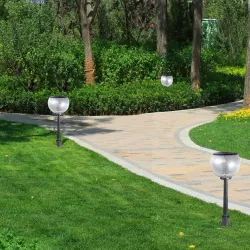Here are common types of outdoor lighting and their applications
2023-12-18
Outdoor lighting serves various purposes, including enhancing the aesthetic appeal of outdoor spaces, improving visibility and safety, and creating a welcoming atmosphere. There are numerous types of outdoor lighting fixtures designed to suit different needs and styles. Here are common types of outdoor lighting and their applications:
1. Path Lights:
- Placement: Along walkways, pathways, or garden borders.
- Purpose: Provide visibility and enhance safety by illuminating paths at ground level.
2. Landscape Spotlights:
- Placement: Aimed at highlighting specific features such as trees, shrubs, or architectural elements.
- Purpose: Adds drama and emphasis to key landscape elements.
3. Floodlights:
- Placement: Mounted on walls or fixtures, directed toward large areas.
- Purpose: Provides broad, intense illumination for security, accenting architectural features, or lighting up larger spaces.
4. Deck and Step Lights:
- Placement: Installed on decks, stairs, or steps.
- Purpose: Adds safety by illuminating potential tripping hazards and enhances the aesthetics of outdoor living spaces.
5. String Lights:
- Placement: Strung between poles, trees, or structures.
- Purpose: Creates a festive and decorative atmosphere for outdoor events or gatherings.
6. Post Lights:
- Placement: Atop posts or pillars, often near entrances or pathways.
- Purpose: Provides ambient lighting and a decorative element to outdoor spaces.
7. Wall Sconces:
- Placement: Mounted on exterior walls.
- Purpose: Offers a combination of functional and decorative lighting for entrances, patios, and porches.
8. Ceiling Lights:
- Placement: Suspended from ceilings, often covered areas like porches or gazebos.
- Purpose: Illuminates covered outdoor spaces, providing overhead lighting.
9. Hanging Lanterns:
- Placement: Suspended from hooks or brackets.
- Purpose: Adds a decorative and ambient light source, often used in garden or patio areas.
10. Bollard Lights:
- Placement: Low, cylindrical fixtures placed along pathways or driveways.
- Purpose: Provides pathway lighting, guides pedestrians, and adds a modern design element.
11. Well Lights:
- Placement: Installed at ground level, often used for uplighting trees or architectural features.
- Purpose: Creates dramatic effects by illuminating elements from below.
12. Outdoor Chandeliers:
- Placement: Suspended from covered outdoor structures.
- Purpose: Adds a touch of elegance to outdoor dining areas or covered patios.
13. Motion-Activated Lights:
- Placement: Anywhere on the property, commonly near entrances.
- Purpose: Enhances security by automatically turning on when motion is detected.
14. Solar-Powered Lights:
- Placement: Anywhere with exposure to sunlight.
- Purpose: Environmentally friendly option that relies on solar energy to power LED lights for accent or pathway lighting.
Considerations for Outdoor Lighting:
- Lighting Design: Plan the placement and types of fixtures to achieve both functional and aesthetic goals.
- Energy Efficiency: Consider LED fixtures for energy efficiency and longer lifespan.
- Weather Resistance: Ensure that fixtures are designed to withstand outdoor conditions, including rain, snow, and UV exposure.
- Lighting Control: Implement timers, motion sensors, or smart lighting systems for efficient control of outdoor lighting.
- Dark Sky Compliance: Consider fixtures that minimize light pollution and meet dark sky standards.
- Installation Height: Consider the appropriate height for mounting fixtures to achieve the desired lighting effects.
Well-planned outdoor lighting not only enhances the visual appeal of your property but also contributes to safety and functionality, allowing you to enjoy outdoor spaces day and night.



